Challenges for Digitalisation in Building Renovation to Enhance the Efficiency of the Process: A Spanish Case Study
Abstract
:1. Introduction
2. Materials and Methods
- On-line questionnaire, as a method of primary data collection. It has been addressed to a vast range of companies and roles in the value chain of construction sector, all around Europe and beyond. It is aimed to gather general information to identify the general trends, barriers, and challenges in digitalisation, particularly in the field of residential renovation.
- Interviews with key agents of the construction field focused mainly on the renovation sector. The interviews have been specifically oriented to complete the information that was obtained from the surveys about barriers and opportunities.
- Workshops that were dedicated to check and validate the results of the survey and interviews through the dialogue with closest stakeholders. The workshops have been held around the Spanish pilot case of the BIM4Ren project in the city of Donostia-San Sebastian.
2.1. Questionnaire for Data Gathering about Stakeholder’s Requirements and Constraints
2.1.1. Structure of the Questionnaire
- Identification of the barriers in the renovation process: This section is structured according to the role of the respondent in the value chain, mapping the different use cases with regard to the phases and stakeholders that were involved, typology of works etc. It is also aimed at assessing the factors in a renovation process which have more relevance for every stakeholder group.
- The potential to overcome the barriers in renovation process through digital tools: In this chapter requirements that digital technologies must have to meet the demands of the respondent are defined.
2.1.2. Classification of the Respondents and Their Link with the Renovation Process
2.2. Interviews
2.3. Workshops
3. Results
3.1. Results Obtained from the Overall Questionnaire
3.1.1. Identification of the Barriers in the Renovation Process
3.1.2. Potential to Overcome the Barriers in Renovation Process through Digital Tools
3.2. Results Focused on the Living Lab of the Spanish Case
3.2.1. Results Obtained from the Questionnaire Focused on the Spanish Case
- Most of the respondents have participated in projects with BIM collaborative processes (52%), 18% were declared as BIM software users, and 20.5% had no experience with BIM. The rest were related to BIM as software developers as well as in the fields for research. These outcomes might be partially biased in comparison with the general sector due to the profile of the companies that are interested in this type of questionnaire, and they do not represent the current situation regarding digitalisation. There is still a challenge for further digitalisation even in the companies that state that they use BIM.
- Overall (61%) of the organisations were planning to invest in BIM (training, hardware, and software) while 11% had not planned any kind of investments;
- The vast majority associate BIM with concepts such as collaborative and information management, a few with the terms efficient, 3D model, and digital information, and none declared BIM as “expensive”;
- The most extended use for BIM among the respondents was architecture, construction, design, and maintenance, and very few respondents (if any) used it for environment, demolition, quality control, planning, or augmented reality;
- Regarding the software that was used in their organisations, the most used were AutoCAD ADT, Revit, and Navisworks, while software such as All plan, Tekla, Solibri, MicroStation, Bentley, or Synchro were minimally used by the Spanish users according to the results;
- The results showed that, for Spain, there were no specialists in the domain of exchange data or a collaborative process manager among the respondents, as have been identified in other countries.
3.2.2. Results Obtained from the Interviews
- Main barriers identified by the private building owner:
- The lack of information about the progress to the owners does not allow them to follow the project and provide inputs;
- Taking into account that the renovation is requested when some relevant damages appeared in the building affecting to resident’s comfort conditions, the key aspect is to solve those pathologies. Otherwise, the purposes of the renovations are not appreciated by the owner;
- The technical project is not usually delivered to the owner at the end of the design phase; only a document is provided at the end setting the conditions of use of the renovated building for maintenance purposes.
- In the case of a social housing company as a public owner [33], the highlights differed slightly with the ones that were identified by the general private owner as it is shown below:
- The energy retrofitting in the residential sector is currently driven by funding, rather than by conviction about the improvement of sustainability, energy savings, and comfort conditions [34];
- Distrust about the joint participation of the architect and contractor in public tenders were highlighted, leading to a lack of persuasion about the advantages of BIM as a collaborative process. They believed that the main advantage of BIM was the possibility of generating visuals and 3D models which helped to persuade the residents to perform the renovation;
- The current public engagement procedures in Spain do not allow the engagement of the Architect and Contractor at the same procedure. These constraints come from the idea that the architect must oversee the contractor’s work and that each stakeholders’ function must be clearly differentiated assuming their own responsibilities;
- In the case of renovation of building blocks, the potential of replicability is not leveraged due to the necessity of designing each one from scratch. It gives rise to important time and economic losses which can be overcome through the use of BIM models;
- Although BIM is considered as a useful tool, a long time is needed to train the staff and it is not a priority for a public organisation;
- In residential use, the preventive facility management after renovation was not common due to the difficulties of registering, managing and following the maintenance activities in the building;
- Main barriers identified by the contractor [35]:
- The mistakes are cumulative along the project (in phases of data gathering, diagnosis, and design) and the contractor must solve all of the problems at the end when the cost of solving is much higher;
- The complexity of increasing industrialisation and the use of advanced tools on the renovation process are limited due to the difficulties of accurate data gathering. The culture of working on-site to adapt components and to manage the inaccuracies is a clear origin for several errors and deviations in the project;
- The lack of traceability and common information to be shared between different stakeholders (architect, contractor, subcontractor, etc.) was a source of issues due to partial information or not updated information, etc. Also, the differences in the specific format to exchange this information the between stakeholders can also contribute to additional errors;
- Lack of confidence among the stakeholders, i.e., the owner usually sees the role of the architect as the controller of the contractor’s work. Even the public engagement procedures are intended to engage separately the different roles, not affording to work in a collaborative way from the beginning.
- Main barriers identified by the architect:
- The data gathering of the façade in the design phase is manually performed using topographic instruments, instead of automatic means (3D scanners photogrammetry, etc.). The drawings are mapped from scratch or from the original drawings if they exist, and the work is often tedious;
- Technical difficulties of collecting information about the materials and constructive systems of the existing building in the design phase, due to the current techniques, are invasive. This creates uncertainties in the construction phase leading sometimes to important economic losses;
- Lack of confidence among stakeholders. The involvement of the residents in the decision making is crucial to ensure their acceptance and, consequently, the success of the project, but a culture of trust is necessary. For that purpose, the owners and residents must be properly informed and oriented on the activities that will affect them to manage their expectations [36];
- Legal issues to solve responsibilities in the project. Currently the architect subcontracts services for designing the structure and main services of the building and they would share duties and responsibilities in case of accident. This is a worrying issue that must be tackled if BIM is used;
- Main barriers identified by the industrials/suppliers
- Their systems and products are often requested in the construction phase, without having been consulted in the design phase. This leads them to select the system that better matches the budget rather than the most suitable according to the specifications, dismissing other proposals due to economic reasons.
- They are highly constrained by the price adjustments since they are pressed by all of the stakeholders (architect, contractor, and subcontractor) in the corresponding phase (project and construction phases) to achieve good deals.
- The analysis revealed that there were some technical troubles about the interoperability between the tools and different file formats that the stakeholders manage. In particular, regarding the case that focused on façade rehabilitation, the exchange format for the 3D model of mouldings was not readable or editable by common BIM programs. This lack of interoperability hinders the moulding suppliers access to the market when the projects are highly digitalised.
- Unawareness of the potential of BIM in the sector. The graphical information is exchanged in dwg format which is understandable by all of the agents that are involved in the project. Only 3D rendering is considered useful to give more value to their job under a commercial perspective.
- The use of BIM requires a strong investment and it is not viewed as necessary in the sector at this moment.
3.2.3. Results Achieved from the Workshops
- Inefficiencies that arise because the information that is necessary for the development is not accessible, it is not homogeneous, it is not updated, and it is not very detailed, etc.
- Inefficiencies that arise due to lack of communication and a good interrelation between the agents that are involved in the rehabilitation process, i.e., a lack of understanding among the agents of the sector, poor communication between agents, non-shared information, and technicians and owners have few communications, etc.
- Inefficiencies that are related to the economic issue, i.e., budget deviation, difficulty to focus/specify prices, and a request of new budgets by the owners (changes of opinion), etc.
- Inefficiencies that are related to the execution of the tasks themselves, i.e., ineffective data collection (erroneous measurement, lack of evidence), lack of supply of materials, lack of planning, and difficult coordination of work times, etc.
- Sensory, IoT monitoring, 3D scanning, 360° cameras, computer vision, and a digital building book for the improvement of data collection and diagnosis [37].
- Market price database tool (currently there is no database for energy renovation) to facilitate pricing.
- Last planner system, a constructive model of the building (with costs and planning) to improve the execution process of the work [38].
- Virtual reality and augmented reality that are intended to facilitate visualisation to users/owners [39].
- Easily understandable BIM models (visual, management), digital communication platform, and applications for the improvement of communication between stakeholders that are applicable to the whole rehabilitation process to improve both the quality of the information and that it is accessible, such as communication and interrelation between agents [40].
3.3. Summary of Results
4. Discussion
4.1. Main Barriers Leading to Inefficiencies on the Renovation Process
4.2. Potential to Overcome the Barriers through the Digital Tools
- The results revealed that most of the stakeholders think that the issues that related to the lack of accuracy and knowledge about the existing building, and imprecision on the modelling conditions can be overcome thanks to the BIM, as well as the lack of communication between stakeholders.
- The major benefits that are provided by digital tools for renovation are the detection of mistakes and the integration of the work in a unique model, followed by the improvement of communication, Aspects such as the time savings, access to tenders, or the use of the models in operation are not considered meaningful.
- Nevertheless, the participants have stated that the reasons for being reluctant to the use of digital tools are the high investment in training and cost, the difficulty of the interoperability between tools and, mainly, because they are not accessible to the whole value chain of the construction process.
- Designers are particularly concerned about the technical issues of the process. Indicators that are related to the accuracy of the information about the existing building are especially relevant for them, as well as other technical issues that allow them to improve the process, such as the organisation of documentation and visualisation. Even though they do not consider cost reduction as a direct priority, they are concerned about the time savings in the part of the process that they are involved, which is obviously related to the cost savings. It is remarkable that, based on the survey, social indicators are not crucial for designers, apart from the social reputation of the company.
- For contractors and subcontractors, economic indicators are the most relevant. Cost reduction is the main priority, followed by other technical and economic issues [46]. It is also noticeable that there is interest in some technical issues, such as the easy visualisation of the solution, the reduction of unforeseen events on site, and the accuracy of the data gathering. These technical aspects may affect the budget significantly, so they could also be indirectly considered as economic indicators. Additionally, the indicators defining the safety and organisation on site seem to be important, but not as much as the indicators defining the collaboration with other stakeholders, which are rated positively. Finally, social aspects that are related to the end user requirements are neither considered nor critical for this group.
- The building owners consider that the most important indicators are economic aspects such as: energy savings, maintenance cost reduction, works cost reduction, and access to finance. Surprisingly, the increase of the building value was not found to be crucial for building owners. Some social indicators that, a priori, could seem to be relevant for building owners, such as space optimisation, aesthetic improvements, or not needing to leave the building during the works are also not as critical for this group. The label or certificates after renovation is the only technical indicator that was rated in the list and is not ranked at all as a priority.
- The industrial companies said that the indicator with a major effect on their businesses is the construction project’s delivery time. Additionally, some technical indicators such as organisation of the material or documentation, easy visualisation of the solution, and easy interaction with the designer and, to a lesser extent, with the contractor, were found to be critical. It is remarkable that the integration of the end-user’s requirements is relevant for the industrials, more than for any of the other stakeholders. In general, the answers from the industrial group differ significantly from those that were gathered from other stakeholders. In this respect, it is particularly noticeable that data accuracy and the improvement of the company’s reputation are not seen as relevant for industrials, while they are for the designers and contractors. In contrast, claims management was found to be of considerable importance for industrials whereas it is not a key indicator neither for designer nor for contractors.
5. Conclusions
- To socialise the technology that will enable the improvement of technological progress.
- To generate a technological demand representing a social progress.
- To promote R&D and/or innovation projects that are centered on the users that participate on those contexts.
- Develop research activities with a user ecosystem. Investigations with users entails the creation and dynamisation of user-based communities generating social and cultural capital.
Author Contributions
Funding
Institutional Review Board Statement
Informed Consent Statement
Data Availability Statement
Acknowledgments
Conflicts of Interest
Appendix A
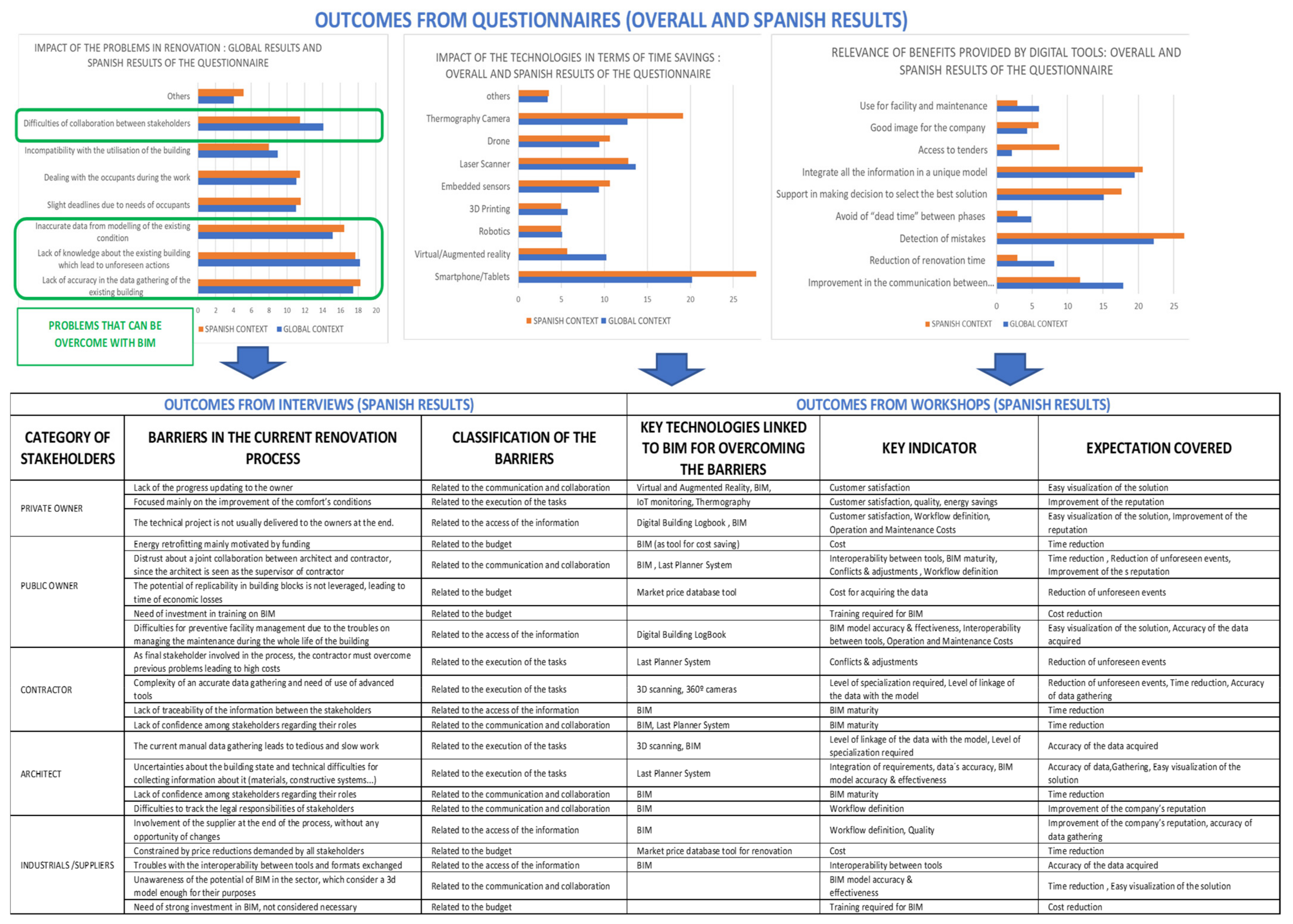
References
- European Construction Sector Observatory. Building Information Modelling in the EU Construction Sector. Trend Paper Series. March 2019. Available online: https://segm.gr/wp-content/uploads/2019/03/ECSO-TP-BIM-in-construction-March-2019.pdf (accessed on 2 July 2021).
- Bolshakov, N.; Badenko, V.; Yadykin, V.; Celani, A. As-built BIM in real estate management: The change of paradigm in digital transformation of economy. IOP Conf. Ser. Mater. Sci. Eng. 2020, 940, 012017. [Google Scholar] [CrossRef]
- Barbosa, F.; Woetzel, J. Reinventing Construction: A Route to Higher Productivity; Mckinsey global institute: New York, NY, USA, 2017; pp. 1–20. [Google Scholar]
- Volk, R.; Stengel, J.; Schultmann, F. Building Information Modeling (BIM) for existing buildings—Literature review and future needs. Autom. Constr. 2014, 38, 109–127. [Google Scholar] [CrossRef] [Green Version]
- World Economic Forum. Shaping the Future of Construction. 2016, p. 5. Available online: http://www3.weforum.org/docs/WEF_Shaping_the_Future_of_Construction_full_report__.pdf (accessed on 27 December 2020).
- Official Journal of the European Union, 2014–EUR-Lex. Available online: https://eur-lex.europa.eu/legal-content/ES/TXT/?uri=celex%3A32014L0024 (accessed on 1 February 2021).
- Instituto de Tecnología de la Construcción, ITeC. Scope of the European Directive on Public Procurement. Available online: https://en.itec.cat/services/bim/directive-2014-24-eu/ (accessed on 2 February 2021).
- European Construction Sector Observatory. Digitalisation in the Construction Sector. Analytical Report. April 2021. Available online: https://ec.europa.eu/docsroom/documents/45547 (accessed on 2 June 2021).
- UNE EN ISO 19650-1:2019. Organización y Digitalización de la Información en Obras de Edificación e Ingeniería Civil que Utilizan BIM (Building Information Modelling). Gestión de la Información al Utilizar BIM (Building Information Modelling). Parte 1. Available online: https://www.une.org/encuentra-tu-norma/busca-tu-norma/norma?c=N0062137 (accessed on 30 June 2020).
- Mellado, F.; Wong, P.F.; Amano, K.; Johnson, C.; Lou, E.C.W. Digitisation of existing buildings to support building assessment schemes: Viability of automated sustainability-led design scan-to-BIM process. Arch. Eng. Des. Manag. 2019, 16, 84–99. [Google Scholar] [CrossRef]
- Jordan-Palomar, I.; Tzortzopoulos, P.; García-Valldecabres, J.; Pellicer, E. Protocol to Manage Heritage-Building Interventions Using Heritage Building Information Modelling (HBIM). Sustainability 2018, 10, 908. [Google Scholar] [CrossRef] [Green Version]
- Edwards, R.E.; Lou, E.C.; Bataw, A.; Kamaruzzaman, S.N.; Johnson, C. Sustainability-led design: Feasibility of incorporating whole-life cycle energy assessment into BIM for refurbishment projects. J. Build. Eng. 2019, 24, 100697. [Google Scholar] [CrossRef]
- BIM4REN Project. Public Deliverable D1-1 Stakeholders Requirements and Constrains. Available online: https://bim4ren.eu/download/d1-1-stakeholders-requirements-and-cobstrains/ (accessed on 29 June 2021).
- BIM4REN Project. Funded by from the European Union’s Horizon 2020 Research and Innovation Program under Grant Agreement n. 820773. Available online: https://bim4ren.eu/ (accessed on 2 June 2021).
- Chan, D.W.; Olawumi, T.O.; Ho, A.M. Perceived benefits of and barriers to Building Information Modelling (BIM) implementation in construction: The case of Hong Kong. J. Build. Eng. 2019, 25, 100764. [Google Scholar] [CrossRef]
- Okakpu, A.; GhaffarianHoseini, A.; Tookey, J.; Haar, J.; GhaffarianHoseini, A.; Rehman, A.U. Risk factors that influence adoption of Building Information Modelling (BIM) for refurbishment of complex building projects: Stakeholders perceptions. Int. J. Constr. Manag. 2020, 1–13. [Google Scholar] [CrossRef]
- Kassem, M.; Succar, B. Macro BIM adoption: Comparative market analysis. Autom. Constr. 2017, 81, 286–299. [Google Scholar] [CrossRef]
- Kiaulakis, A.; Vilutienė, T.; Šarka, V.; Šarkienė, E. Construction project stakeholders’ perceptions and expectations of their roles in BIM-based collaboration. In Proceedings of the 13th International Conference Modern Building Materials, Structures and Techniques, Vilnius, Lithuania, 16–17 May 2019; Lithuania Vilnius Gediminas Technical University: Vilnius, Lithuania, 2019. [Google Scholar] [CrossRef]
- Wang, Y.; Thangasamy, V.K.; Hou, Z.; Tiong, R.L.; Zhang, L. Collaborative relationship discovery in BIM project delivery: A social network analysis approach. Autom. Constr. 2020, 114, 103147. [Google Scholar] [CrossRef]
- Okakpu, A.; GhaffarianHoseini, A.; Tookey, J.; Haar, J.; Hoseini, A.G. An optimisation process to motivate effective adoption of BIM for refurbishment of complex buildings in New Zealand. Front. Arch. Res. 2019, 8, 646–661. [Google Scholar] [CrossRef]
- Von Geibler, J.; Erdmann, L.; Liedtke, C.; Rohn, H.; Stabe, M.; Berner, S.; Leismann, K.; Schnalzer, K.; Kennedy, K. Exploring the Potential of a German Living Lab Research Infrastructure for the Development of Low Resource Products and Services. Resource 2014, 3, 575–598. [Google Scholar] [CrossRef] [Green Version]
- Andersson, S.; Rahe, U. Accelerate innovation towards sustainable living: Exploring the potential of Living Labs in a recently completed case. J. Des. Res. 2017, 15, 234. [Google Scholar] [CrossRef] [Green Version]
- Korsnes, M.; Berker, T.; Woods, R. Domestication, acceptance and zero emission ambitions: Insights from a mixed method, experimental research design in a Norwegian Living Lab. Energy Res. Soc. Sci. 2018, 39, 226–233. [Google Scholar] [CrossRef]
- Coleman, S.; Robinson, J.B. Introducing the qualitative performance gap: Stories about a sustainable building. Build. Res. Inf. 2018, 46, 485–500. [Google Scholar] [CrossRef]
- Ahmed, A.; McGough, D.; Mateo-Garcia, M. Testing innovative technologies for retrofitting: Coventry University as a living lab. Entrep. Sustain. Issues 2017, 4, 257–270. [Google Scholar] [CrossRef] [Green Version]
- Chien, S.-C.; Chuang, T.-C.; Yu, H.-S.; Han, Y.; Soong, B.H.; Tseng, K.J. Implementation of Cloud BIM-based Platform Towards High-performance Building Services. Procedia Environ. Sci. 2017, 38, 436–444. [Google Scholar] [CrossRef]
- Badawy, M.; El-Aziz, A.A.; Idress, A.M.; Hefny, H.; Hossam, S. A survey on exploring key performance indicators. Futur. Comput. Inform. J. 2016, 1, 47–52. [Google Scholar] [CrossRef]
- Elagiry, M.; Marino, V.; Lasarte, N.; Elguezabal, P.; Messervey, T. BIM4Ren: Barriers to BIM Implementation in Renovation Processes in the Italian Market. Buildings 2019, 9, 200. [Google Scholar] [CrossRef] [Green Version]
- Flammini, A.; Pasetti, M.; Rinaldi, S.; Bellagente, P.; Ciribini, A.C.; Tagliabue, L.C.; Zavanella, L.E.; Zanoni, S.; Oggioni, G.; Pedrazzi, G. A Living Lab and Testing Infrastructure for the Development of Innovative Smart Energy Solutions: The eLUX Laboratory of the University of Brescia. In Proceedings of the 2018 AEIT International Annual Conference, Bari, Italy, 3–5 October 2018; pp. 1–6. [Google Scholar]
- Lime Survey. On-Line Open-Source Software. Available online: https://www.limesurvey.org/es/ (accessed on 18 June 2020).
- Laing, R.; Leon, M.; Mahdjoubi, L.; Scott, J. Integrating Rapid 3D Data Collection Techniques to Support BIM Design Decision Making. Procedia Environ. Sci. 2014, 22, 120–130. [Google Scholar] [CrossRef] [Green Version]
- Leśniak, A.; Górka, M.; Skrzypczak, I. Barriers to BIM Implementation in Architecture, Construction, and Engineering Projects—The Polish Study. Energies 2021, 14, 2090. [Google Scholar] [CrossRef]
- Computer Integrated Construction Research Program. BIM Planning Guide for Facility Owners, Version 2.0; Pennsylvania State University, University Park: State College, PA, USA, 2013; pp. 1–69. [Google Scholar]
- Bimchannel. Del BIM en Alquiler al BIM Social: BIM Aplicado a Gestión de Viviendas Públicas en Alquiler. Available online: https://bimchannel.net/es/del-bim-en-alquiler-al-bim-social/ (accessed on 18 June 2020).
- Vishnivetskaya, A.; Mikhailova, A. Employment of BIM technologies for residential quarters renovation: Global experience and prospects of implementation in Russia. IOP Conf. Ser. Mater. Sci. Eng. 2019, 497, 012020. [Google Scholar] [CrossRef] [Green Version]
- Poirier, E.; Staub-French, S.; Forgues, D. Assessing the performance of the building information modeling (BIM) implementation process within a small specialty contracting enterprise. Can. J. Civ. Eng. 2015, 42, 766–778. [Google Scholar] [CrossRef]
- Cheng, J.C.; Chen, W.; Chen, K.; Wang, Q. Data-driven predictive maintenance planning framework for MEP components based on BIM and IoT using machine learning algorithms. Autom. Constr. 2020, 112, 103087. [Google Scholar] [CrossRef]
- Heigermoser, D.; Garcia de Soto, B.; Sidney Abbott, E.L.; Chua, D.K.H. BIM-based Last Planner System tool for improving construction project management. Autom. Constr. 2019, 104, 246–254. [Google Scholar] [CrossRef]
- Wang, J.; Wang, X.; Shou, W.; Xu, B. Integrating BIM and augmented reality for interactive architectural visualisation. Constr. Innov. 2014, 14, 453–476. [Google Scholar] [CrossRef]
- Daniotti, B.; Bolognesi, C.; Spagnolo, S.L.; Pavan, A.; Signorini, M.; Ciuffreda, S.; Mirarchi, C.; Lucky, M.; Andersson, B.; Andersson, P.; et al. An Interoperable BIM-Based Toolkit for Efficient Renovation in Buildings. Buildings 2021, 11, 271. [Google Scholar] [CrossRef]
- Toor, S.-U.-R.; Ogunlana, S.O. Beyond the ‘iron triangle’: Stakeholder perception of key performance indicators (KPIs) for large-scale public sector development projects. Int. J. Proj. Manag. 2010, 28, 228–236. [Google Scholar] [CrossRef]
- Dombrowski, U.; Schmidtchen, K.; Ebentreich, D. Balanced Key Performance Indicators in Product Development. Int. J. Mater. Mech. Manuf. 2013, 1, 27–31. [Google Scholar] [CrossRef] [Green Version]
- Villazón, C.C.; Pinilla, L.S.; Olaso, J.R.O.; Gandarias, N.T.; De Lacalle, N.L. Identification of Key Performance Indicators in Project-Based Organisations through the Lean Approach. Sustainability 2020, 12, 5977. [Google Scholar] [CrossRef]
- Abd, A.M.; Khamees, A.S. As built case studies for BIM as conflicts detection and documentation tool. Cogent Eng. 2017, 4, 1411865. [Google Scholar] [CrossRef]
- Love, P.E.D.; Matthews, J.; Simpson, I.; Hill, A.; Olatunji, O.A. A benefits realization management building information modeling framework for asset owners. Autom. Constr. 2014, 37, 1–10. [Google Scholar] [CrossRef]
- Kim, J.-U.; Hadadi, O.A.; Kim, H.; Kim, J. Development of A BIM-Based Maintenance Decision-Making Framework for the Optimization between Energy Efficiency and Investment Costs. Sustainability 2018, 10, 2480. [Google Scholar] [CrossRef] [Green Version]
- Hossain, M.A.; Yeoh, J.K.W. BIM for Existing Buildings: Potential Opportunities and Barriers. IOP Conf. Ser. Mater. Sci. Eng. 2018, 371, 012051. [Google Scholar] [CrossRef]
- Charef, R.; Emmitt, S. Uses of building information modelling for overcoming barriers to a circular economy. J. Clean. Prod. 2021, 285, 124854. [Google Scholar] [CrossRef]
- Hu, Z.-Z.; Leng, S.; Lin, J.-R.; Li, S.-W.; Xiao, Y.-Q. Knowledge Extraction and Discovery Based on BIM: A Critical Review and Future Directions. Arch. Comput. Methods Eng. 2021, 1–22. [Google Scholar] [CrossRef]
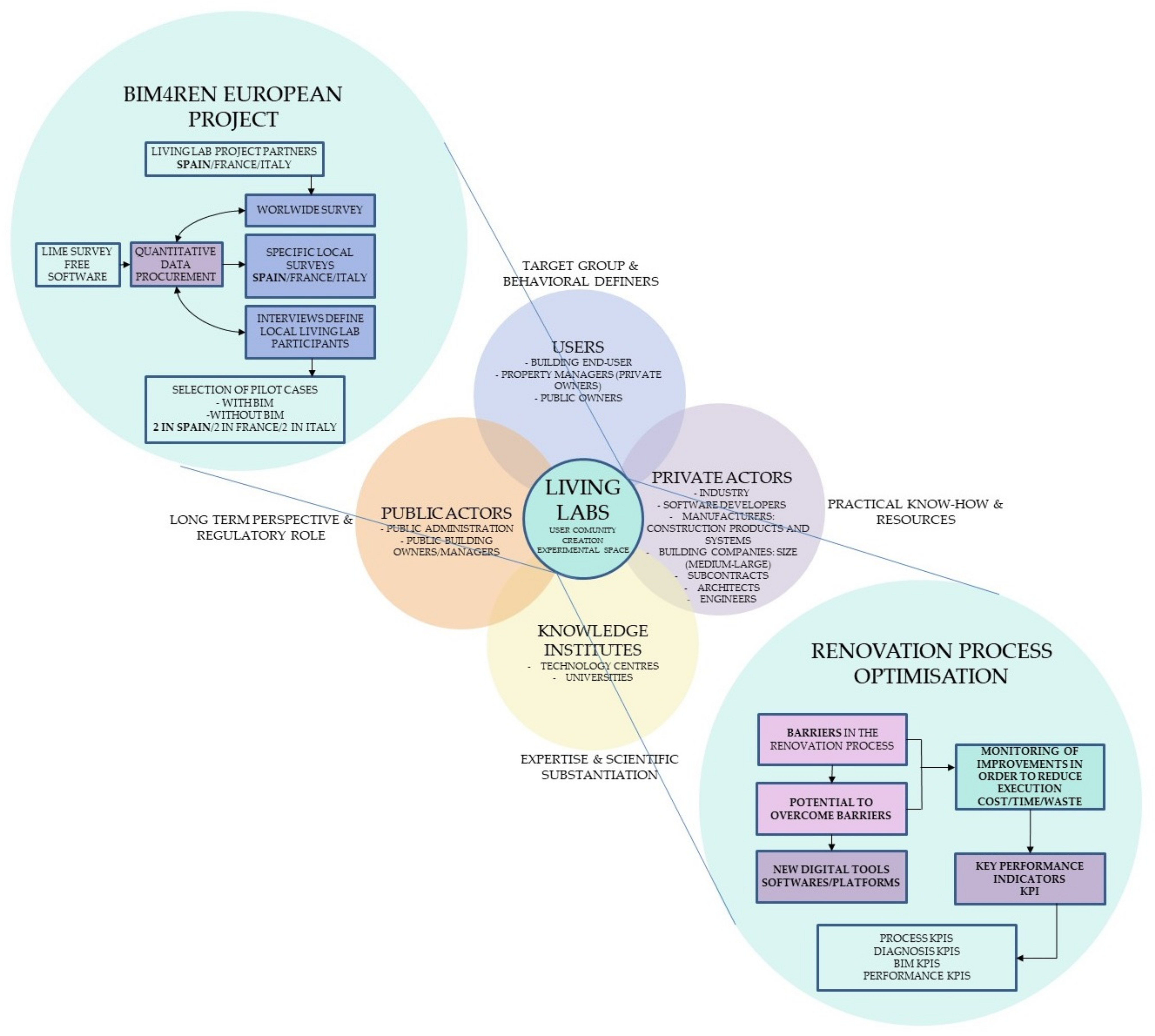
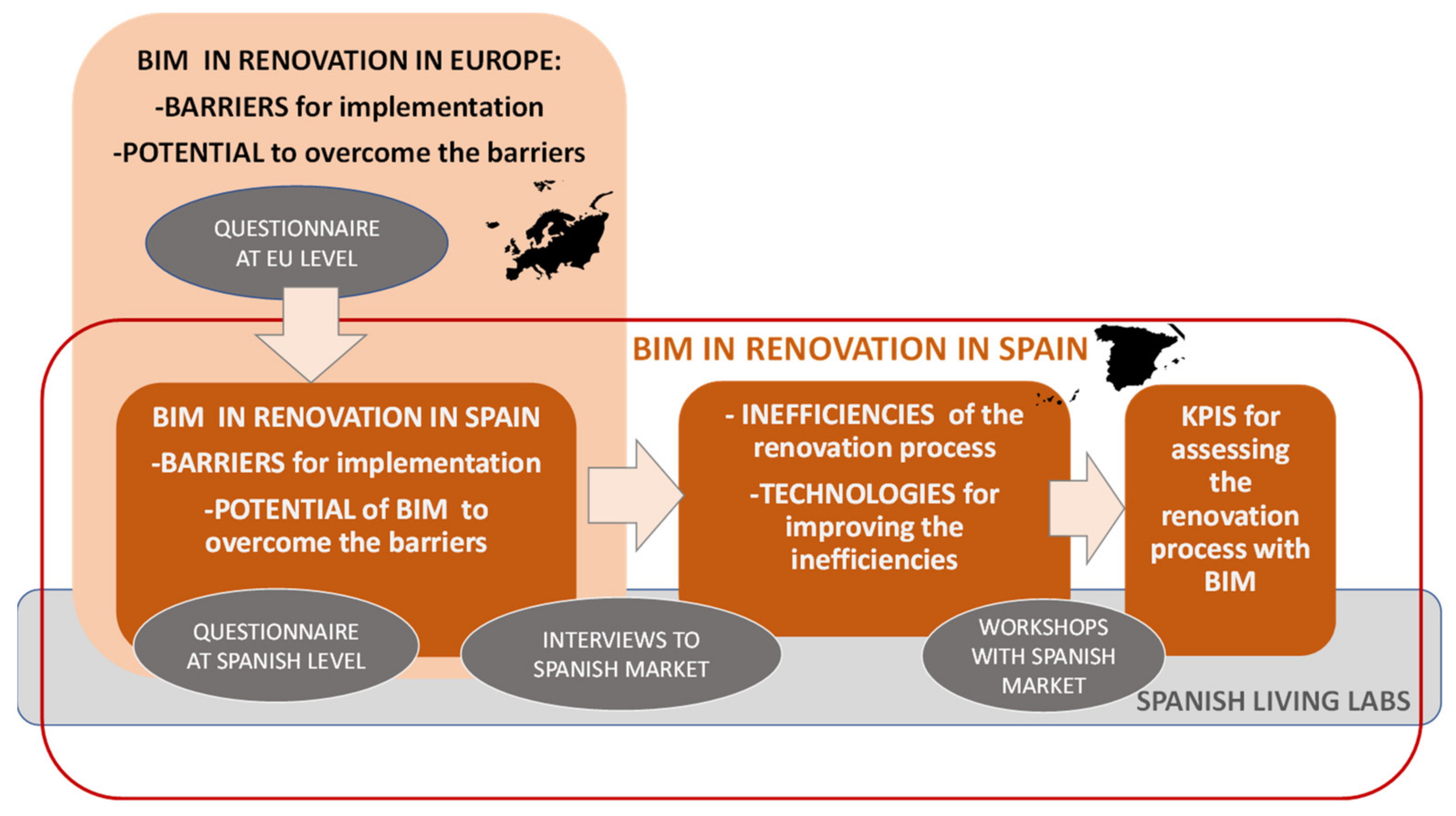
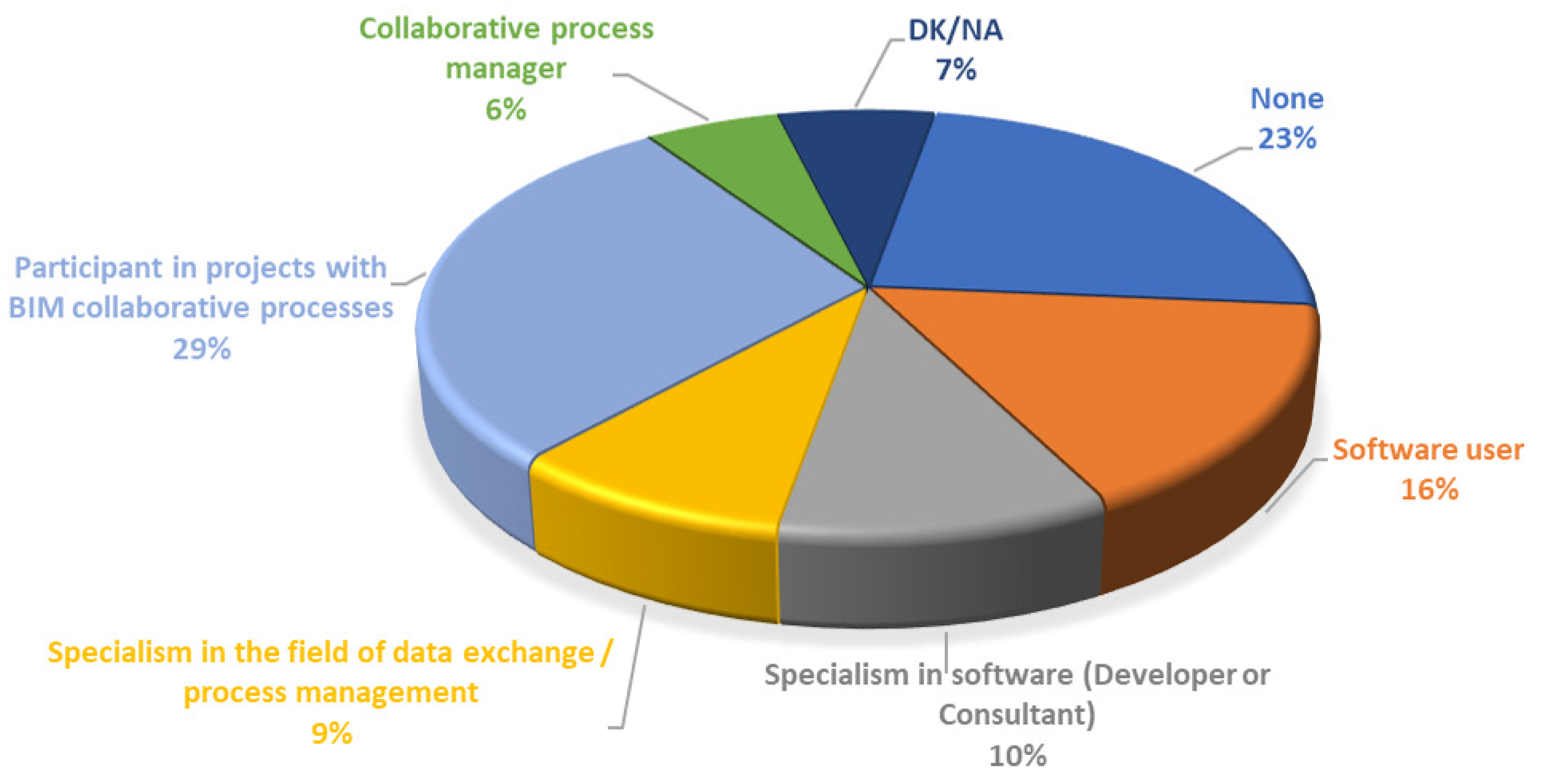
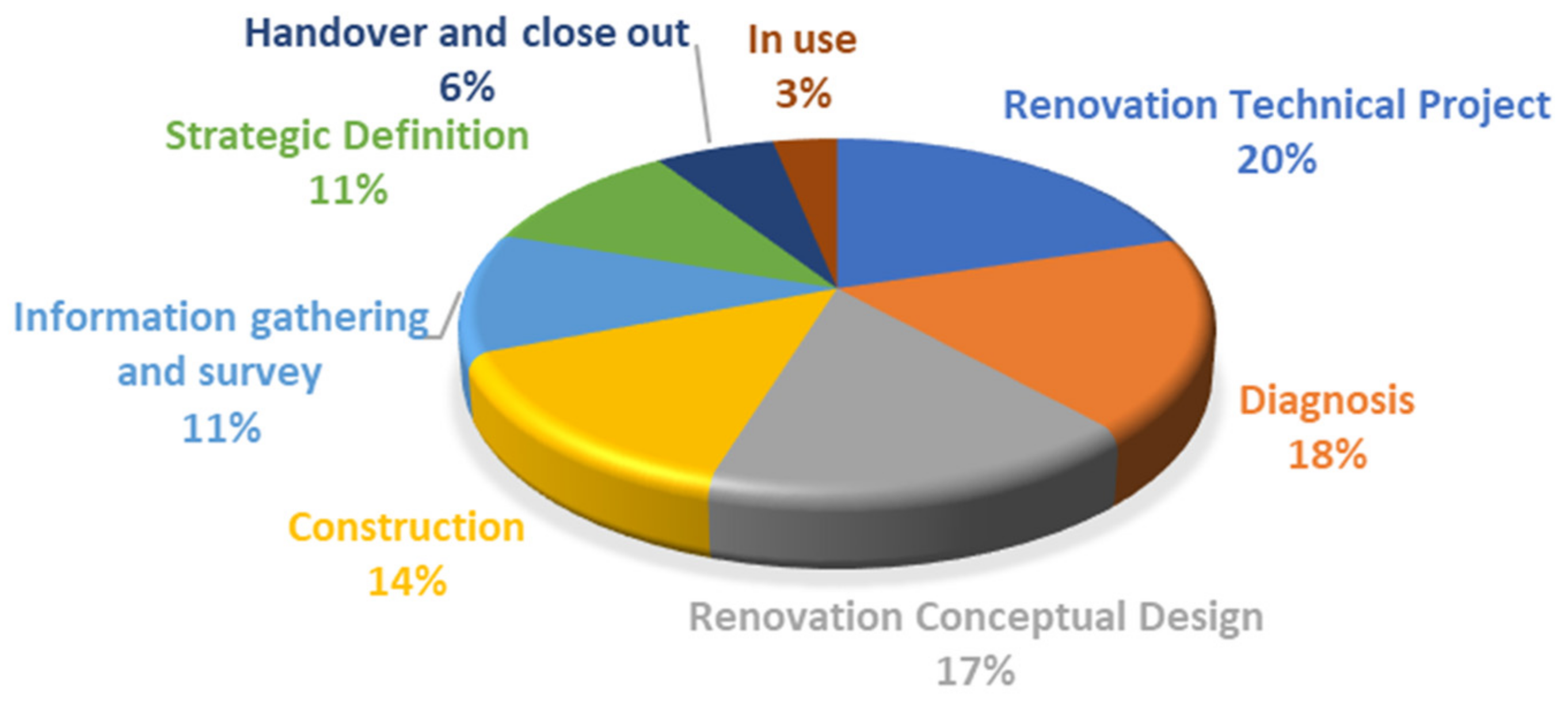
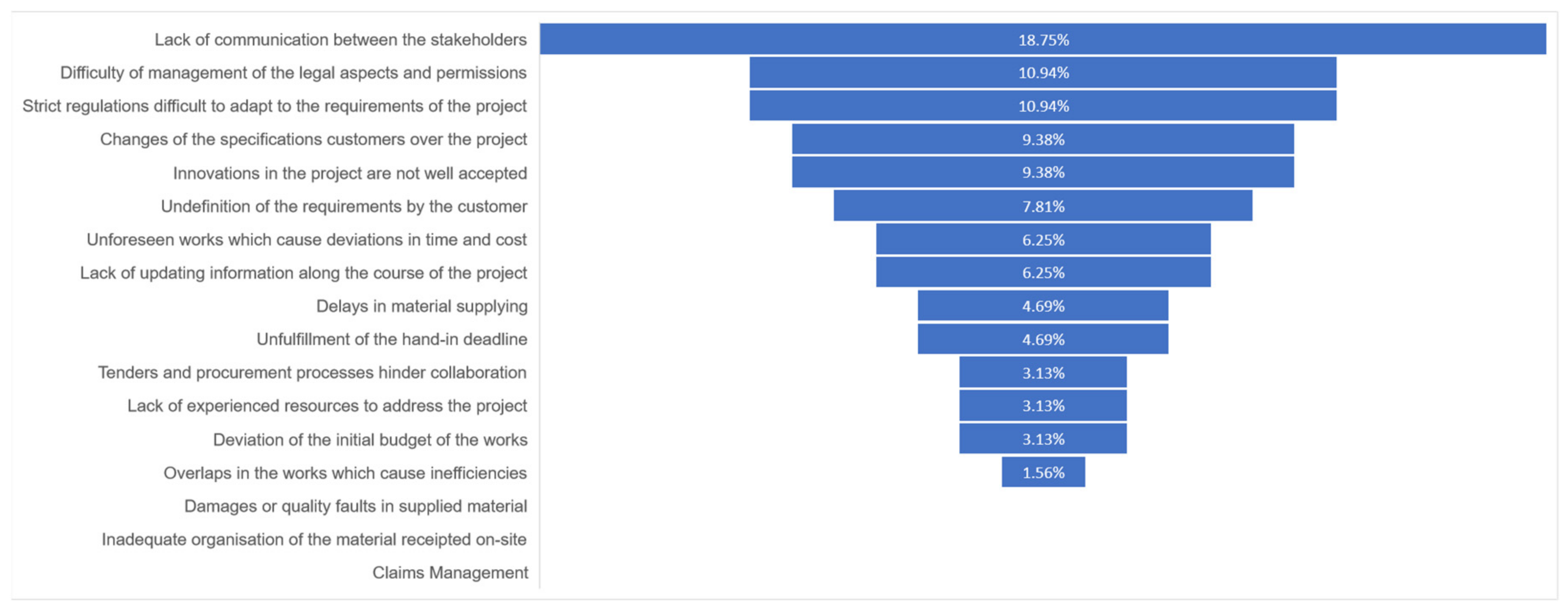
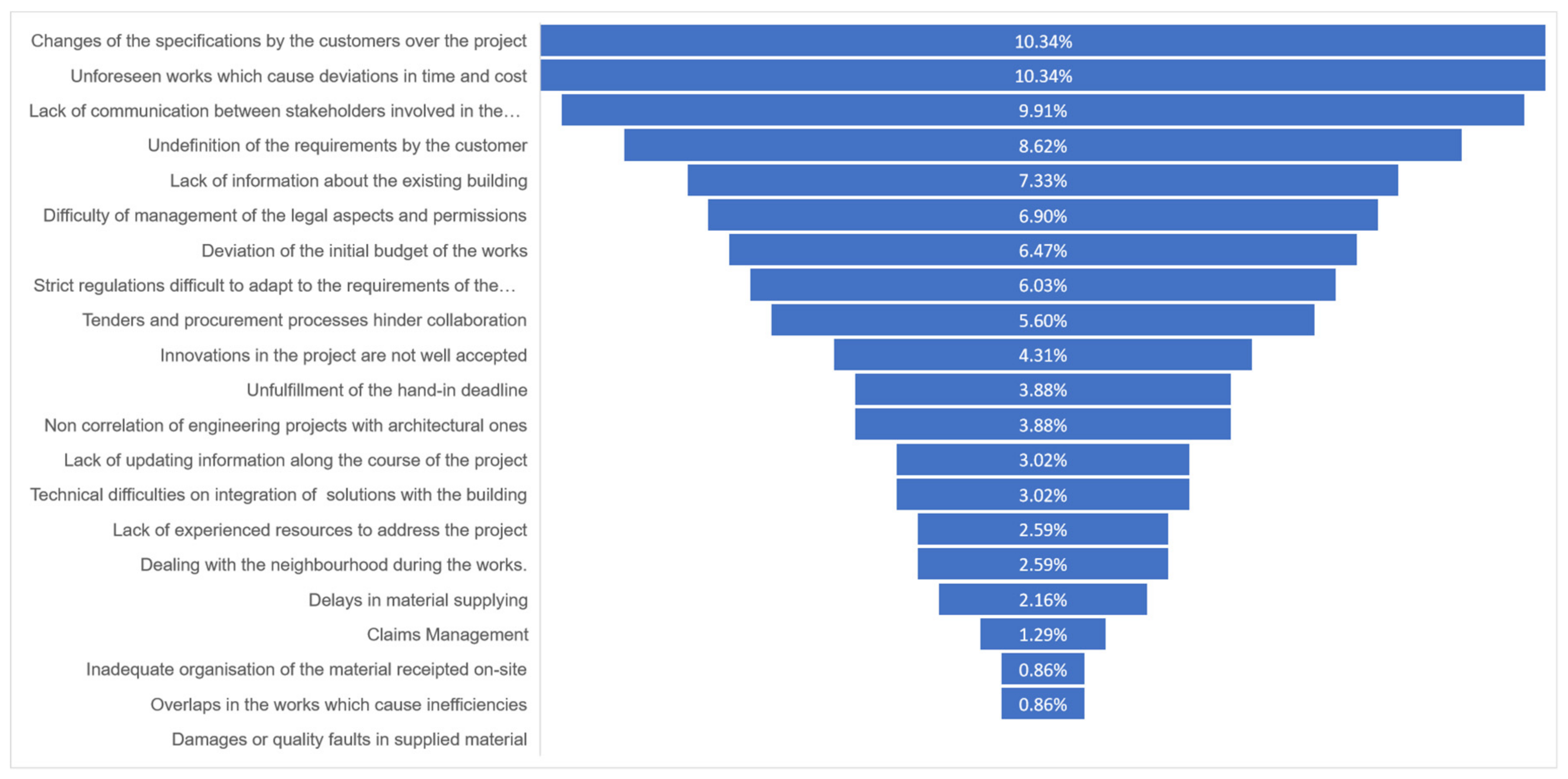
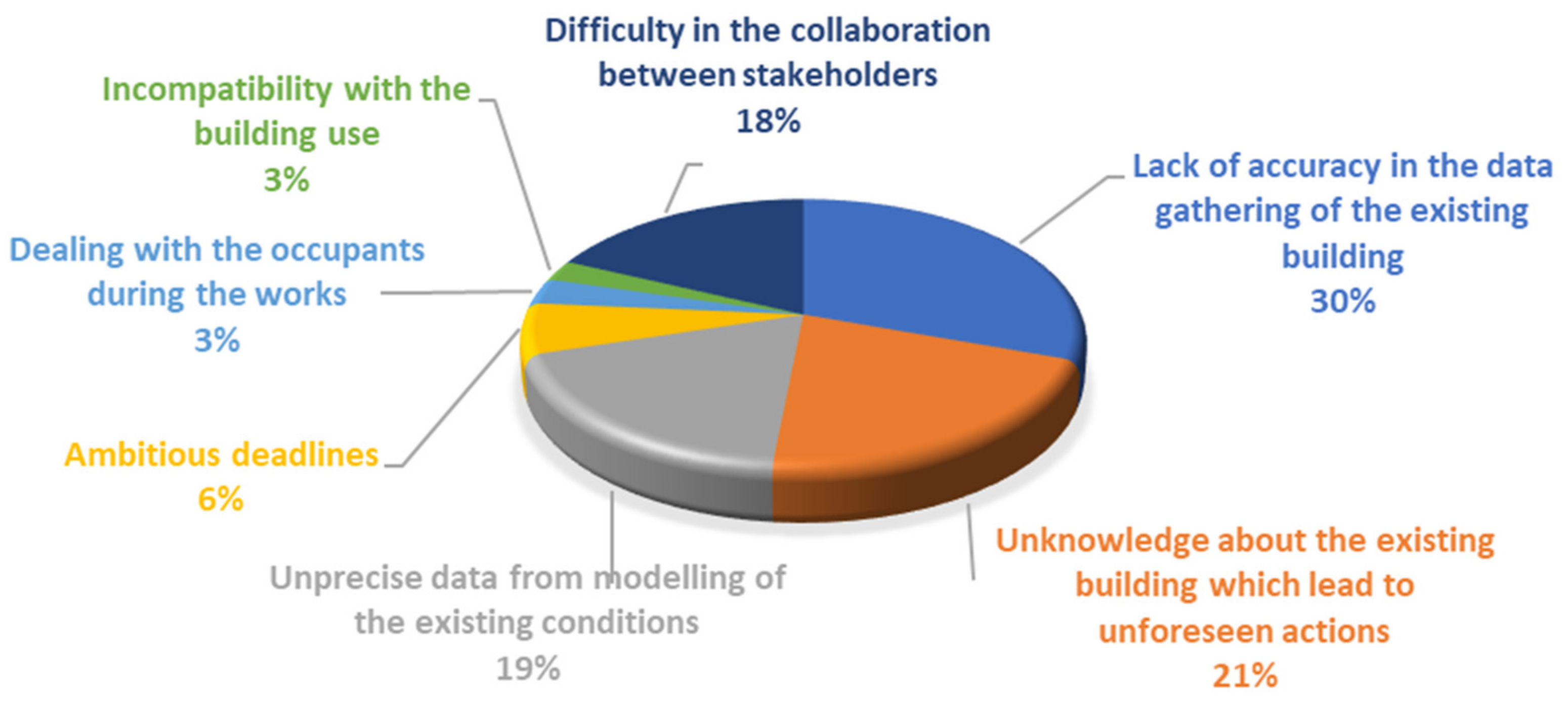
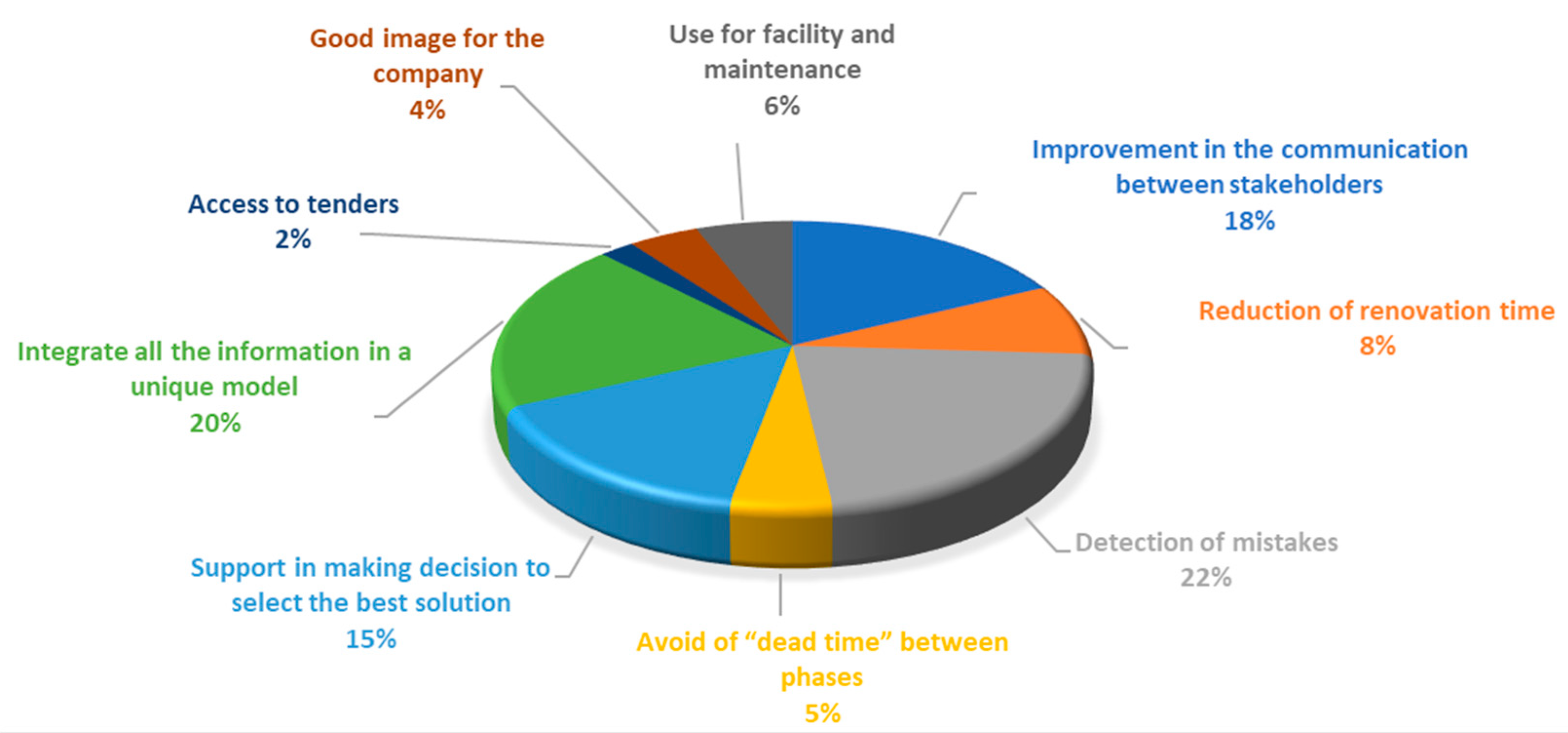

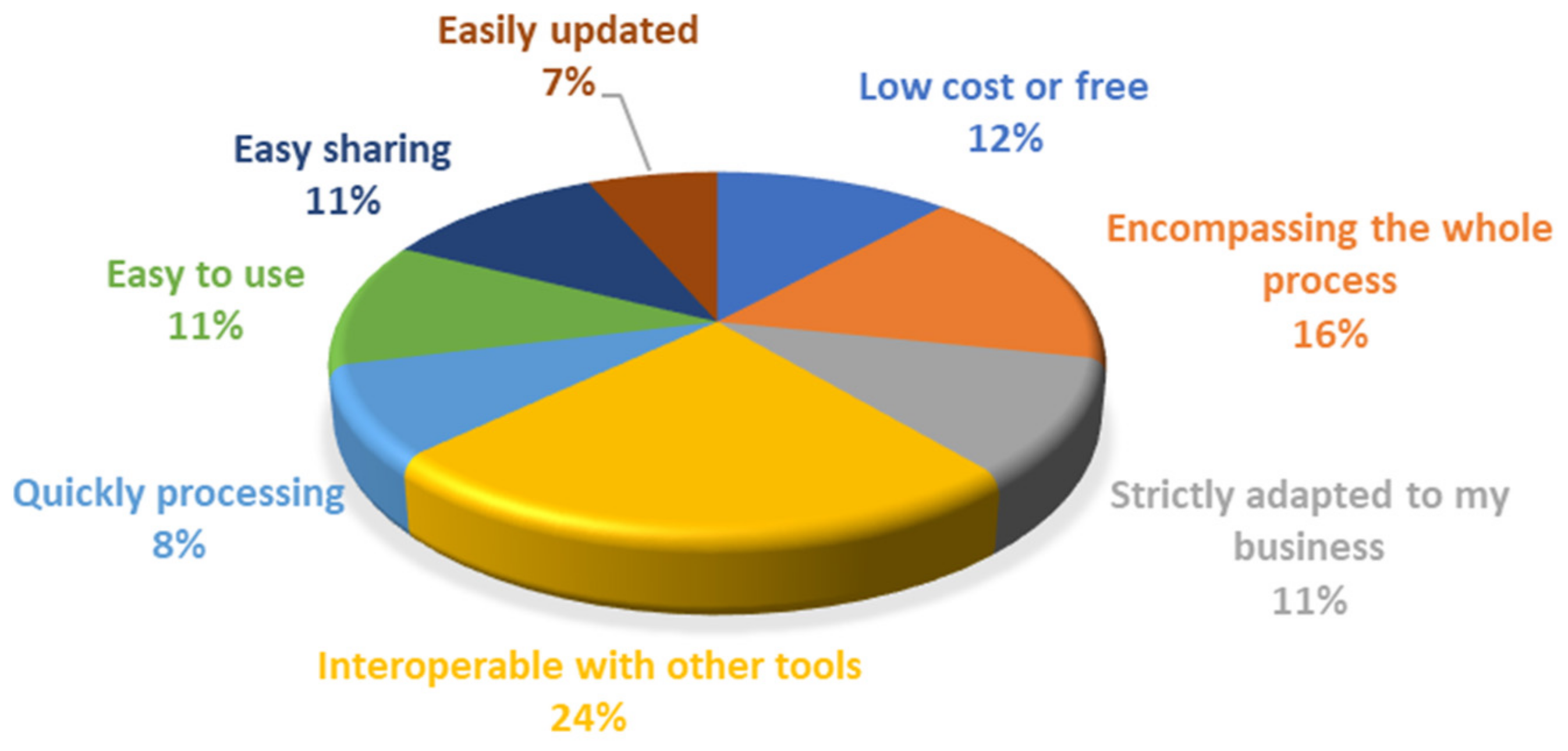

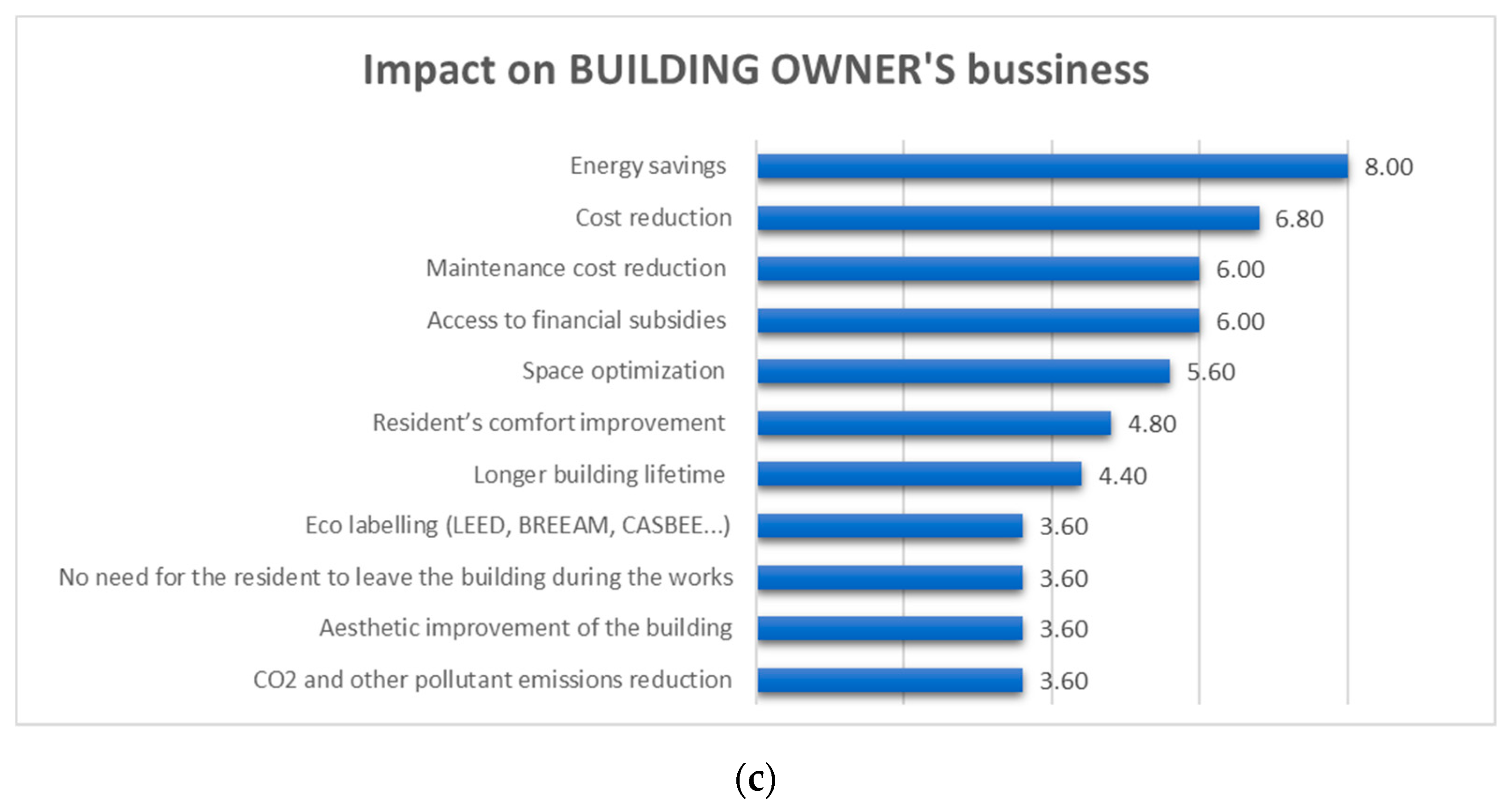
| Categories of Stakeholders | Sub-Categories of Stakeholders |
|---|---|
| Designer | Project Manager Architect Structural Engineer Survey and data gathering Services Engineer Work controller |
| Contractor and Subcontractor | On site worker Cost controller Quality controller Installer Security manager Site manager Others Data gathering |
| Building owner and/or resident | Site manager Buildings manager Facility manager/Maintenance Building administrator Others |
| Public administration | Local authority Waste manager Industrial Department Security authority |
| Industry | Supplier Manufacturer Others |
| Others | Software developer or consultant External certificatory Funders Education and training on BIM software |
| Prioritisation of Used Technologies | |||
|---|---|---|---|
| According to the Time Savings They Bring | According to the Cost Savings They Bring | ||
| 1 | Laser scanner | 1 | Laser scanner |
| 2 | Smartphone/Tablets | 2 | Embedded sensors |
| 3 | Thermography Camera | 3 | Smartphone/Tablets |
| 4 | Embedded sensors | 4 | Thermography Camera |
| 5 | Drone | 5 | Drone |
| 6 | Virtual/Augmented reality | 6 | Virtual/Augmented reality |
| 7 | Robotics | 7 | Others |
| 8 | Others | 8 | 3D printing |
| 9 | 3D printing | 9 | Robotics |
| Key Aspects for the Success of a Renovation Process | Relevance | ||||
|---|---|---|---|---|---|
| Designer | Contractor & Subcontractors | Building Owners | Industry | Others | |
| Accuracy of the data gathering of the existing building | *** | *** | * | *** | |
| Easy visualisation of the solution | *** | *** | ** | ** | |
| Reduction of delivery time | *** | *** | ** | ||
| Organisation of the documentation | *** | ** | ** | *** | |
| Cost reduction | *** | *** | *** | *** | ** |
| Improvement of the company’s reputation | ** | ** | * | ** | |
| Create best practices | ** | ||||
| Validation of the standards compliance | ** | ** | * | ** | |
| Justification of the Decision Making | ** | ** | |||
| Easy replication | ** | ** | |||
| Easy collaboration with the client | ** | ** | |||
| Integration of requests from residents | * | ||||
| Reduction of the visits to site | * | * | |||
| Complaint management | * | * | ** | * | |
| Access to financial subsidies | ** | * | |||
| Maintenance cost reduction | *** | ** | |||
| Energy savings | *** | *** | |||
| Resident’s comfort improvement | *** | ** | |||
| CO2 and other pollutant emissions reduction | ** | ** | |||
| Support to the control quality | ** | *** | |||
| Longer building lifetime | *** | ** | |||
| Aesthetic improvement of the building | ** | * | |||
| No need for the resident to leave the building during the works | * | * | |||
| Reduction of accidents on site | ** | * | |||
| Reduction of unforeseen events on site | *** | ** | |||
| Reduction of execution works time | *** | * | |||
| Easy interaction with the designer | *** | *** | |||
| Easy collaboration with suppliers | ** | ||||
| Reduction of number of workers on site | ** | ||||
| Support to classification of the material on site | * | ||||
| Integration of requests from residents | * | *** | ** | ||
| Eco labelling (LEED, BREEAM, CASBEE…) of the building after renovation | * | ||||
| Space optimisation | * | ||||
| Increase in the building value | * | ** | |||
| Organisation of the material onsite | *** | ||||
| Easy interaction with the contractor | ** | ||||
| Indicator Group | Identified Indicators | Expectations Covered | Related Stakeholders |
|---|---|---|---|
| Process indicators | Cost | Reduction of time | All stakeholders |
| Time | Cost reduction | All stakeholders | |
| Quality | Accuracy of data gathering | Designers | |
| Forecast accuracy | Improvement of the company’s reputation | Designer | |
| Customer satisfaction | Easy visualisation of the solution | Owners | |
| Diagnosis Indicators | Data’s accuracy | Accuracy of the data acquired | Designers |
| Cost for acquiring the data | Reduction of unforeseen events | Contractor | |
| Level of specialisation required | |||
| Level of linkage of the data with the model | |||
| BIM indicators | BIM maturity | Reduction of time | All stakeholders |
| Training required for BIM | Cost reduction | All stakeholders | |
| Integration of requirements | Accuracy of data gathering | Designers | |
| Workflow definition | Improvement of the company’s reputation | Designer | |
| BIM model accuracy & effectiveness | Easy visualisation of the solution | Designer, contractor, and others | |
| Conflicts & adjustments | Reduction of unforeseen events | Contractor | |
| Interoperability between tools | Accuracy of the data acquired | ||
| Performance indicators | Energy Saving | Owners | |
| Operation and Maintenance Costs | Owners |
Publisher’s Note: MDPI stays neutral with regard to jurisdictional claims in published maps and institutional affiliations. |
© 2021 by the authors. Licensee MDPI, Basel, Switzerland. This article is an open access article distributed under the terms and conditions of the Creative Commons Attribution (CC BY) license (https://creativecommons.org/licenses/by/4.0/).
Share and Cite
Lasarte, N.; Elguezabal, P.; Sagarna, M.; Leon, I.; Otaduy, J.P. Challenges for Digitalisation in Building Renovation to Enhance the Efficiency of the Process: A Spanish Case Study. Sustainability 2021, 13, 12139. https://doi.org/10.3390/su132112139
Lasarte N, Elguezabal P, Sagarna M, Leon I, Otaduy JP. Challenges for Digitalisation in Building Renovation to Enhance the Efficiency of the Process: A Spanish Case Study. Sustainability. 2021; 13(21):12139. https://doi.org/10.3390/su132112139
Chicago/Turabian StyleLasarte, Natalia, Peru Elguezabal, Maialen Sagarna, Iñigo Leon, and Juan Pedro Otaduy. 2021. "Challenges for Digitalisation in Building Renovation to Enhance the Efficiency of the Process: A Spanish Case Study" Sustainability 13, no. 21: 12139. https://doi.org/10.3390/su132112139
APA StyleLasarte, N., Elguezabal, P., Sagarna, M., Leon, I., & Otaduy, J. P. (2021). Challenges for Digitalisation in Building Renovation to Enhance the Efficiency of the Process: A Spanish Case Study. Sustainability, 13(21), 12139. https://doi.org/10.3390/su132112139






